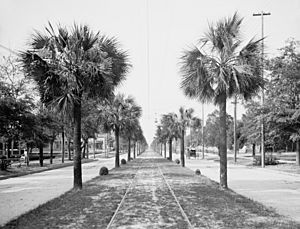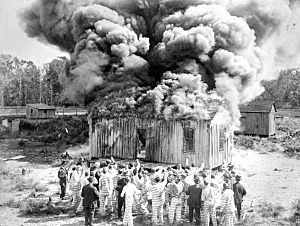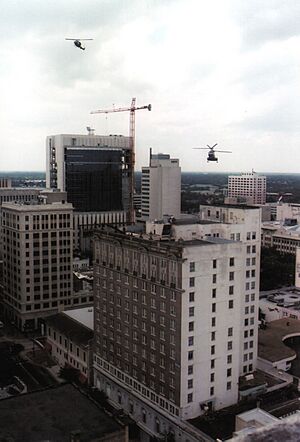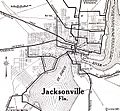History of Jacksonville, Florida facts for kids
Jacksonville, Florida, started as a small British settlement called Cow Ford in the late 1700s. It grew a lot in the late 1800s, becoming a popular winter spot for tourists. Major events like the Great Fire of 1901 and economic problems slowed its growth at times. However, since the late 1900s, the city has been growing steadily.
Since 1940, Jacksonville has also been a very important port for the United States Navy. Today, it's a busy city with over a million people. Because its city and county governments joined together, Jacksonville has the largest population of any city in Florida. It also covers the largest land area of any city in the contiguous United States (the main 48 states).
Quick facts for kids History of Florida |
|
|---|---|
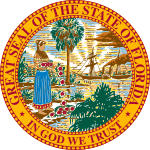
The seal of Florida reflects the state's Native American ancestry
|
|
| Historical Periods | |
| Pre-history | until 1497 |
| Spanish Rule | 1513–1763 |
| British Rule | 1763–1783 |
| Spanish Rule | 1783–1821 |
| U.S. Territorial Period | 1822–1845 |
| Statehood | 1845–present |
| Major Events | |
| American Revolutionary War | 1775–1783 |
| War of 1812 | 1811–1814 |
| First Seminole War | 1817–1818 |
| Capitol moved to Tallahassee |
1824 |
| Second Seminole War | 1835–1842 |
| Constitutional convention | 1838 |
| Third Seminole War | 1855–1858 |
| Ordinance of Secession | 1861 |
| Civil War | 1861–1865 |
| 3rd Constitution | 1865 |
| Reconstruction | 1865–1868 |
| 4th Constitution | 1868 |
| 5th Constitution | 1885 |
| Great Migration | 1910–1930 |
| Land Boom | 1925–1929 |
| 6th Constitution | 1968 |
| Gore v. Harris 2000 Presidential Election |
2000 |
| Timeline | |
Contents
Jacksonville's Early History
Ancient Times in Jacksonville
Scientists have found signs that people lived in the Jacksonville area for about 6,000 years. They even found pottery from 2500 BC, which is some of the oldest in the United States.
In the 1500s, when Europeans first arrived, the area was home to the Mocama people. They were a group of Timucua Native Americans. Most Mocama villages in Jacksonville were part of a powerful group called the Saturiwa. They lived near Fort George Island and had a complex society that fit well with their environment.
European Settlers and Conflicts
In 1513, Spanish explorers landed in Florida and claimed the land for Spain. The first Europeans to visit the Jacksonville area were Spanish explorers and missionaries.
In 1562, a French naval officer named Jean Ribault arrived with 150 settlers. They were looking for a safe place for French Protestants called Huguenots. Ribault explored the St. Johns River before moving north.
In 1564, Ribault's former officer, René Goulaine de Laudonnière, started a new trip to build a colony on the St. Johns River. On June 22, 1564, they built Fort Caroline on St. Johns Bluff.
Laudonnière made friends with the local Timucua tribe, the Saturiwa. He also became friendly with their rivals, the Utina tribe, who lived further upriver. The French colony faced hunger and problems.
In 1565, the Spanish admiral Pedro Menéndez de Avilés built a Spanish colony called St. Augustine 35 miles south. His goal was to remove the French. Ribault tried to attack the Spanish, but a storm damaged his ships. On September 20, 1565, Menéndez marched to Fort Caroline. He captured the fort and killed most of the French settlers.
The Spanish took over Fort Caroline and renamed it San Matteo. In 1568, the French attacked again and burned it down. The Spanish rebuilt it but left in 1569. They then built Fort San Nicolas further upriver to protect St. Augustine. The area was known as "San Nicolas," and that name still exists in the St. Nicholas neighborhood today.
British Rule and the Cow Ford
After the French and Indian War, the British took control of Florida from Spain in 1763. The British built the King's Road, connecting St. Augustine to Georgia. This road crossed the St. Johns River at a narrow spot. The Seminole people called this spot Wacca Pilatka, and the British called it the "Cow Ford." Both names came from the fact that cattle were led across the river there.
The British encouraged people to move to Florida by offering land grants. Many British colonists came from South Carolina, Georgia, and England. This was the first time a large English-speaking population lived in what is now Duval County and nearby areas. The British improved roads and started growing crops like sugar cane and indigo. Florida's economy grew much more under British rule. The British also brought their legal system, including trial-by-jury and county governments, which Florida still uses today.
Florida Becomes Part of the U.S.
In 1783, the British gave Florida back to Spain. However, American settlers from Georgia and South Carolina continued to move into northern Florida. These settlers, mixed with the English-speaking people already there, became known as Florida Crackers.
Between 1812 and 1814, during the War of 1812, the U.S. Navy helped American settlers try to take control of Florida from Spain. Spain eventually sold the Florida Territory to the United States in 1821.
By 1822, the name Jacksonville was being used to honor General Andrew Jackson. He was the military governor of the Florida Territory and later became President. On February 9, 1832, settlers led by Isaiah D. Hart created a plan for a town government, which was approved. Hart is remembered as an important founder, and the Hart Bridge over the St. Johns River is named after him.
Jacksonville During the Civil War

During the American Civil War, Jacksonville was important for sending supplies like hogs and cattle to help the Confederate side. The U.S. Navy blocked Florida's ports, including Jacksonville.
In October 1862, Union forces captured a Confederate fort and took over Jacksonville. The city changed hands several times during the war, but without major battles.
On February 20, 1864, Union soldiers from Jacksonville fought the Confederate Army at the Battle of Olustee. Most Union soldiers in this battle were African-American, while most Confederate soldiers were from Florida. This battle was a big loss for the Union.
After the war ended in 1865, a Union commander said Jacksonville was "pathetically dilapidated," meaning it was very run-down and damaged by the war.
Jacksonville After the Civil War
A Winter Getaway City
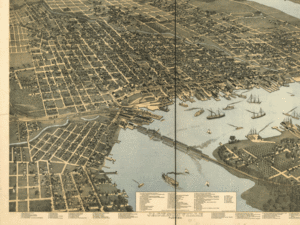
After the American Civil War, Jacksonville became a popular winter resort for wealthy people. Visitors came by steamboat and later by railroad. They stayed in many hotels and boarding houses.
However, Jacksonville's popularity as a resort declined after Henry Flagler extended his Florida East Coast Railroad further south. This brought tourists to new destinations like Palm Beach and Miami.
Yellow Fever Outbreaks
Jacksonville's reputation as a healthy tourist spot also suffered from major yellow fever outbreaks in 1886 and 1888. During the second outbreak, nearly 10% of the 4,000 people who got sick died. Many residents panicked and fled the city. Mail was even fumigated to try and stop the spread of the disease.
Spanish–American War Role
During the Spanish–American War, people who were helping the Cuban rebels used Jacksonville to smuggle weapons and supplies to Cuba. Duval County sheriff Napoleon B. Broward was one of these gunrunners. Author Stephen Crane also came to Jacksonville to report on the war.
Jacksonville in the 20th Century
The Great Fire of 1901
On May 3, 1901, a huge fire destroyed downtown Jacksonville. It was the largest urban fire ever in the Southeastern United States. The fire started when hot ash from a chimney landed on drying moss at a factory. Within eight hours, the fire destroyed the business district and left 10,000 people homeless.
Rebuilding started right away. Young architect Henry John Klutho came to Jacksonville after hearing about the fire. He and other architects designed many new buildings in the "Prairie Style." Some of Klutho's buildings still stand today, like the St. James Building (now City Hall) and the Morocco Temple. Jacksonville still has one of the largest collections of Prairie Style buildings outside the Midwest.
Jacksonville's Movie Industry
In the early 1900s, before Hollywood became famous, the movie industry was based in New Jersey. Moviemakers came to Jacksonville for its warm weather, interesting locations, good train access, and cheaper workers. This earned Jacksonville the nickname "The Winter Film Capital of the World."
More than 30 silent film companies set up studios in Jacksonville. Famous comedic actor Oliver Hardy started his movie career here in 1914. The first movie made in Technicolor, The Gulf Between, was also filmed in Jacksonville in 1917.
Jacksonville was especially important for African American films. Producer Richard Norman made movies starring black actors, showing them in positive roles.
However, many conservative residents of Jacksonville didn't like the movie industry's activities, like car chases in the streets. In 1917, a new mayor was elected who wanted to control the movie industry. At the same time, southern California was becoming the main movie production center. These factors quickly led to the end of Jacksonville as a major film city.
"Gateway to Florida"
The 1920s brought a lot of building and land buying to Jacksonville during the Florida land boom. Many train passengers passed through Jacksonville on their way to new tourist spots in South Florida.
When the Dixie Highway (which became U.S. 1) was finished in the 1920s, more cars started coming through. Since the 1870s, Jacksonville had been an important entry point to Florida. Now, it truly earned its nickname, "Gateway to Florida."
A big reason for Jacksonville's growth in the 20th century was the presence of navy bases. On October 15, 1940, Naval Air Station Jacksonville ("NAS Jax") opened. This base was a major training center during World War II, training over 20,000 pilots. Today, NAS Jax is the third-largest navy base in the country.
In June 1941, Naval Air Station Cecil Field opened. During the Cold War, it became a major jet base. In 1993, the Navy decided to close NAS Cecil Field, and it was completed in 1999. The land is now called the "Cecil Commerce Center."
In December 1942, Naval Station Mayport opened at the mouth of the St. Johns River. This port is home to many navy ships. It was home to the aircraft carrier USS John F. Kennedy from 1995 to 2007. NS Mayport currently employs about 14,000 people.
Jacksonville is also close to Naval Submarine Base Kings Bay in Georgia. This base is home to some of the U.S. Navy's nuclear-powered submarines.
The navy bases helped Jacksonville's population grow a lot. By 1970, more than half of the residents had a connection to the navy base. This led to the opening of an international airport.
Hotel Roosevelt Fire
On December 29, 1963, a fire badly damaged the Hotel Roosevelt on Adams Street. It killed 22 people, making it the deadliest single day in Jacksonville's history. The hotel was later abandoned.
Hurricanes and Jacksonville
Jacksonville is one of the few cities on the East Coast that has mostly avoided strong hurricanes. Even after Hurricane Dora caused damage in Jacksonville on September 10, 1964, over 20,000 fans still went to a concert by "The Beatles" the very next day!
Dora was the only storm in recorded history to hit Jacksonville with hurricane-force winds. In September 1999, after Hurricane Floyd hit the Bahamas, over a million Floridians were evacuated from coastal areas, including many from Jacksonville. Mayor John Delaney ordered people to leave the Jacksonville Beaches. However, the storm turned away, causing only minor damage in Jacksonville.
City and County Join Forces
In the 1960s, Jacksonville, like many other large cities, faced problems from urban sprawl. To help with population loss and money issues, voters decided to join the government of Jacksonville with the government of Duval County. This happened on October 1, 1968. Hans Tanzler became the first mayor of the new, combined government.
Jacksonville became the largest city in Florida and the 13th largest in the United States by land area. All parts of Duval County are considered part of Jacksonville, except for four smaller independent towns: Jacksonville Beach, Atlantic Beach, Neptune Beach, and Baldwin. However, people in these towns can still vote in city elections and use Jacksonville's services.
Images


